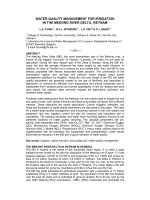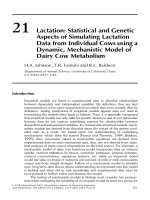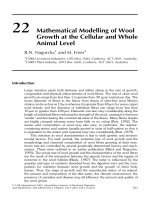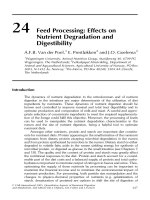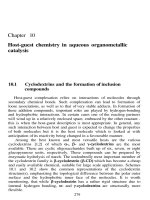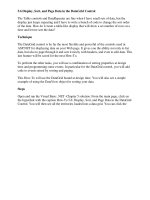Tài liệu Market Analysis of Hydroponic Lettuce in the Nashville Region pdf
Bạn đang xem bản rút gọn của tài liệu. Xem và tải ngay bản đầy đủ của tài liệu tại đây (332.32 KB, 32 trang )
Market Analysis of Hydroponic Lettuce in the
Nashville Region
Min Huang
Meng Li
John Rutter
Jeremy Walters
Pornpat Wiwattarangkul
Advanced Agribusiness Marketing
April 23, 2002
Table of Contents
Page
Introduction
1
Definition of Problem
3
Objectives
4
Review of Industry Information
5
Market Analysis
Data Sources and Methodology
8
Restaurant Survey
9
Wholesaler Survey
10
Results
11
Conclusions & Recommendation
13
References
16
Appendices
18
1
Executive Summary
Inflated quota prices for tobacco have discontinued the use of many greenhouses for
tobacco production in Tennessee. The result has been idle greenhouses. Idle greenhouses will
not earn the producer revenue, so new profitable alternatives must be sought. One alternative is
to use the greenhouse for the production of hydroponic vegetables.
One type of vegetable that is hydroponically grown is head lettuce. Hydroponic lettuce
can be grown year round and harvested every 35 days, allowing for quick turnover. The product
attributes are better and even more consistent than that of traditional lettuce.
The objective of this study was to ascertain whether or not a market existed for
hydroponic lettuce in the Nashville region. The study also sought to find any hydroponic
vegetables that had an insufficient supply. To accomplish these objectives, the study
concentrated on evaluating the supply and sources of lettuce to restaurants and the feasibility of
selling hydroponic lettuce to the wholesale market.
The results of the analysis concluded that there was only a limited market for hydroponic
lettuce. In order for the producer to be successful in this market, the producer would need to
establish a wholesaler and use a push strategy to develop customers for the product. The
analysis also concluded that there was a market for hydroponic tomatoes and cucumbers.
Therefore, the producer has the option of continuing to produce hydroponic lettuce, the producer
could grow other hydroponic vegetables, or the producer could grow a mixture of hydroponic
lettuce as well as other hydroponic vegetables.
Introduction
Many tobacco producers in Tennessee have left their greenhouses idle due to inflated
quota prices. Since the costs of building the greenhouses have already been incurred, and vacant
2
greenhouses have the opportunity of increasing farm incomes, many tobacco producers have
attempted to find alternative uses for their greenhouse to earn additional revenue. Using tobacco
greenhouse to grow fresh vegetables and fruits has been widely practiced by tobacco growers,
who currently possess an empty greenhouse. In addition, greenhouses give farmers the advantage
of producing fruits and vegetables in a controlled environment.
Hydroponics is defined as the growing of plants and nutrient solutions with or without an
inert medium to provide mechanical support. Hydroponics is basically the science of growing
plants without soil. The key to hydroponics is a complete nutrient that is water-soluble and
contains all the elements required for plant growth, including the trace elements, such as copper,
iron, zinc, boron, and calcium.
Hydroponic vegetable production has caught producers’ attention in utilizing an empty
greenhouse. Hydroponic lettuce is one type of vegetable that many farmers have chosen to
produce in their greenhouse. A picture of hydroponic lettuce is presented in Figure 1. The major
advantages of hydroponic lettuce include a short production period, availability year round, and
consistency of product attributes. The life cycle of hydroponic lettuce is very short compared to
traditionally grown lettuce; growers can harvest hydroponic lettuce after 35 days of production.
In greenhouse production, temperature can be controlled year round to provide the optimal level
of lettuce.
3
Figure 1. Hydroponic Lettuce
This also means that growers can supply their lettuce when demand is high. Constant supply of
fresh vegetables is considered to be crucial for green market consumers, either for commercial or
residential purposes, as they have a constant demand1. Growers may be able to assure their
consumers of a constant price or small fluctuation in price due to variation in production factors.
Producing lettuce without soil and inside a controlled environment helps growers to produce
clean product with beautiful color and leaf shape. The appearance of green products greatly
accounts for good market price and high profit. Another advantage of hydroponic lettuce is that it
can be grown close to the market distributor. As a perishable product, long distance
transportation may damage and lower market value of the product. Moreover, having the product
located near the consumer can considerably reduce transportation and other related cost.
1
Green market consumers are those who purchase fresh and nutritional vegetables regularly.
4
Definition of the Problem and Objectives
Since hydroponic lettuce is new to the market, it is believed that the market is not fully
established. Recognition of hydroponic vegetables is not yet developed among consumers who
regularly purchase fresh vegetables. Currently, there is no evidence of sufficient demand for
hydroponic lettuce. Hydroponics may follow the path of organic vegetables that has taken a
decade to fully obtain consumer recognition. Therefore, the study needs to define the primary
target consumers and secondary consumers. Education programs are needed to make consumers
aware of the benefits of hydroponic lettuce. While hydroponic lettuce is currently not widely
available to consumers, supply is expected to expand.
Price is another issue. There is no common market price for hydroponic lettuce. The price
varies from one grower to another as costs of production of each producer differ. Furthermore,
the price of hydroponic lettuce is considered to be relatively high compared to price of traditional
lettuce in normal season. Variation of price between stores and between traditional and
hydroponic lettuce are presented in Table 1 (price may vary to different prices received by
growers and markup). During the normal season of lettuce, one head of traditional lettuce usually
costs around $1. However, a head of hydroponic lettuce can cost from $1.5 to $3.
Table 1. Lettuce price comparison between stores around Kingston Pike
Traditional lettuce
Hydroponic Lettuce
Store
Weight
Weight
(lb.)
(lb.)
Approximate Price*
Approximate Price*
Farm Fresh
.69 – 1.69
1
1.49
.3
Market
Fresh Market
1.19 – 2.5
1
1.99
2.99
Kroger
1.19 – 3
1.5
*All prices were collected during April 2002.
5
.5
.5
According to the National Organic Program (NOP) regulations, hydroponic lettuce
cannot be filed and labeled as organic.2 Hydroponic lettuce is soil-free but not entirely chemical
free, so they do not meet the requirement of the NOP regulations. In addition, there are the
penalties for the misuse of the term “organic”. That is, the adoption of the term organic does not
provide benefits for the farmers who grow hydroponic lettuce. Producers may convey
information on advantages of being hydroponic to consumers by labeling them on the package;
this would be most helpful if the end-users are residential consumers but have little influence on
commercial consumers.
The purposes of this study are to evaluate supply and sources of lettuce to estimate and
examine the feasibility of selling hydroponic lettuce on wholesale markets. Also, this study will
determine whether or not a market exists for hydroponic lettuce and examine alternative
hydroponic vegetables that have insufficient supply.
Review of Industry information
Since hydroponic lettuce is considered new to the market, previous studies and industry
information about marketing hydroponic lettuce are not widely available. Therefore, current
market information on traditional lettuce would be used to substitute industry information of
hydroponic lettuce.
Nearly 100 percent of the traditional field grown lettuce consumed in the United States is
produced domestically. The vast majority of domestic production takes place in two states:
California and Arizona. (Lewrene et al., 2001). A relatively small number of firms coordinate the
growing, processing and transport of lettuce. Because of the long shipping distance from
2
The National Organic Program regulates that producers and handlers must be certified by a USDA accredited
certifying agent to sell, label, or represent their products as “organic”. www.ams.usda.gov.
6
production sites to consumers around the country, lettuce has to be picked before its maturity,
which affect appearance, taste, and freshness. Another problem is the increased transportation
costs due to long distances. In addition, field grown lettuce has soil related problems such as
weeds, insects, and disease. Pesticide residues in the fresh vegetable products may also cause
food safety issues among consumers. The traditional field grown products can be affected by the
weather or season significantly. During bad weather periods, producers can only supply poor
quality lettuce at a high price. That is, prices may vary greatly due to uncontrolled weather. All
of the above problems with traditional field grown lettuce encourage the development of the
local hydroponic lettuce market.
Over the past two decades, consumers across the country have become more aware of
their health, so consumption of vegetables has been trending upward. Per capita consumption of
fresh leafy green vegetables increased 14.3 percent from 162.4 pounds in 1987 to 185.6 pounds
in 1997 (USDA, Vegetables and Specialties and Outlook Yearbook, 1999). One of the leading
leafy green vegetables consumed, head lettuce, has been strongly dominated by market trends.
Rising incomes have been cited in Kaufman et al. (2000) as a factor that enabled consumers to
purchase higher quality and greater variety of vegetables. Therefore, organic and locally grown
vegetables appear to have high potential to attract consumers dollars. Lettuces of all types
account for the largest share of farm cash receipts for leafy green vegetables. Moreover,
production of lettuce varieties has jumped 40 percent from 1989 to 1996 (Effland, 1998).
Several market channels are available for producers, such as direct market, retail stores,
foodservices, bagged salad and wholesalers. Since the producer that we are working with has a
relatively small-scale operation compared to Archer Daniels Midland (ADM), market
distribution of lettuce through wholesalers would be utilized. Sales of wholesalers increased
7
about 65 percent from $34.5 billion in 1987 to $53 billion in 1997 as well as continued growth in
nontraditional produce such as organic and specialty items has been beneficial to wholesalers
(Kaufman et al., 2000). These high-margin products are difficult for supermarket chains to buy
directly from growers, since individual chains do not have the volume to purchase or organize
trailer loads of those products. Even though, head lettuce is the main leafy green vegetable
contained in bagged salad, hydroponic lettuce is not usually included in the bagged salad. The
main reason is that hydroponic lettuce wilts easier than the traditional lettuce when packed in the
bagged salad. Therefore, distributing hydroponic lettuce through bagged salad processors will be
neglected in this study.
A study of greenhouse vegetable production from North Carolina State University
indicated that production is higher in the field. For greenhouse production to be profitable a price
premium must also be available, because operating costs are comparatively high. Greenhouse
vegetable production is very labor-intensive, requiring 7-12 workers per ha unless transplants are
purchased, or packing is done off-site. In addition, at least some workers must be skilled in
working with hydroponic plant growing system, which also has to be purchased. This means that
the quality must be consistently high and greenhouse product must be clearly differentiated from
field-grown products.
A tissue analysis of soilless culture peppers has been cited by some wholesalers in
California that hydroponic peppers not only contain more vitamins than soil grown peppers, but
they also contain no trace of heavy metals that are harmful to human consumption. Adding this
quality, some wholesalers in California are selling their hydroponic produce to organic grocers in
certain area. This evidence may lead and pave the way to market hydroponic produces for
growers in other regions.
8
The hydroponic lettuce is usually sold in plastic crispers that keep the lettuce fresh and
prevent damage during transportation. The crystal clear crisper, which has a hinged lid and has a
cup in the bottom for the roots, gives the product a clean and fresh image.
Previous studies show that the market preference for different types of leafy green
vegetables appear to be variable. Most people, who were raised in the South, are familiar with
and like more flavorful leaf lettuces; however, people from the Northern U.S. are more familiar
with head lettuces and are generally willing to pay a premium price for high quality. Their
general migration to the South has changed the demographics of the region such that the present
population is not as familiar with and is less likely to purchase leaf lettuce. In addition, the ethnic
populations in many areas of the Southeast are increasing in numbers, and many of these people
prefer the stronger, more flavorful vegetables. They are more likely to use leaf lettuce and more
oriented greens (R. Allen Straw et. Al, 1998). At present it appears that retailers and consumers
in the Southeastern U.S., use little leaf lettuce; however, head lettuce enjoys a relatively strong
and constant demand.
Methods
The approach taken in the hydroponic lettuce study was to establish what the supply and
source of lettuce was to restaurants and to evaluate the wholesale market. Earlier research
indicated that hydroponic lettuce could not be bagged or processed, so the market analysis
excluded these as a potential market participants. In addition grocery stores were believed to be
supplied by distributors and wholesalers, so our analysis of the wholesale market would give
indications of the grocer demand.
9
In order to contact individuals for the surveys, the Real Yellow Pages web site3 was used
to identify participants. Once the results were found, the restaurant survey was narrowed down
and the participants were contacted by phone.
The questions on the surveys were asked in a manner to achieve the objectives of the
survey. In both cases, the surveys were designed to be easy to follow and limited the amount of
time the restaurant and wholesale participant had to spend on the survey.
Restaurant Survey
The intent of the restaurant survey was to determine if the restaurants used head lettuce
and how much the restaurants used on a daily basis. The objectives to the survey are as follows:
(i.)
Determine what is the producers’ supply?
(ii.)
Who are the market participants?
(iii.)
What the demand for lettuce is by restaurants?
(iv.)
Who were the restaurant suppliers?
As indicated earlier, the Real Yellow Pages were used to gather restaurant information.
The restaurant listing had 2309 restaurants from the Nashville area. The number of restaurant
types was narrowed down by categories to a manageable number to survey. Fast food and other
similar restaurant types were excluded from the survey list. The restaurant categories that were
used for the survey included American, Beef, Cajun, Casual, Chicken, Chops, Fine Dining,
Gourmet, Italian, Mediterranean, Salads, Sandwiches, Seafood, Steaks, and Submarines. After
separating the listing, half of the 70 restaurants were contacted to save time and money
(Appendix B).
10
For questions 3,4, and 5, number values were assigned to each of the different possible
outcomes, so a spreadsheet program could interpret the data. The number values for the third
question were wholesalers = 1, chain distributor = 2, and other = 3. For the fourth question, the
values were $0-$5 = 1, $5 -$15 = 2, $15 - $25 = 3, and $25+ = 4. The fifth question values were
national chain = 1, local or regional chain = 2, and independently owned = 3.
Wholesaler Survey
The intent of the wholesaler survey was to find the amount of hydroponic vegetables that
are currently sold in the Nashville region and to evaluate the market for hydroponic lettuce. In
doing so, the survey would address the following seven objectives.
(i.)
How many wholesalers carry hydroponic vegetables?
(ii.)
What type of wholesalers would be willing to purchase hydroponic lettuce?
(iii.)
Would a local producer influence the wholesalers’ decision to purchase
hydroponic lettuce?
(iv.)
What are wholesalers willing to pay for hydroponic lettuce?
(v.)
What characteristics of lettuce are important to wholesalers?
(vi.)
What factors effect wholesalers' purchase behavior?
(vii.)
Is there a demand for any hydroponically grown vegetables that have an
insufficient supply?
Using the Real Yellow Pages web site, there were 15 fruit and vegetable wholesalers in
the Nashville area. Each of the wholesalers were contacted and asked to participate in the
survey, which can be found in Appendix C. The wholesaler survey contained both open-ended
and close-ended questions. Close-ended questions only required the wholesaler to reply with a
11
yes or no answer in which yes = 1 and no = 0. Close-ended questions relating to the
characteristics of lettuce and factors effecting purchase behavior used a scale of 1 to 5 with 1
being the least important and 5 being the most important. Open-ended questions allowed
wholesalers to respond differently with the objective of finding additional information.
Results
The restaurant survey had 15 out of 35 responses with a rate of 43% (Appendix D).
While two of the restaurants refused to participate in the survey, most of the restaurants that did
not respond were closed or had moved to another locations. For others, the manager was not
available. Of the 43% that responded to the survey,73% of those respondents were market
participants for head lettuce.
Of the restaurants that were market participants, 9% used less than 10 heads of lettuce per
day, 55% used between 10 to 20 heads of lettuce per day, and 36% used more than 20 heads of
lettuce per day (Appendix D, Figure 1). Of the surveyed restaurants, 73% purchased from a
wholesaler and the other 27% purchased from a chain distributor (Appendix D, Figure 2). The
restaurants were asked the average price of an entrée served at their establishment; 45.5%
charged between $5 to $15 per entrée, 45.5% charged between $15 to $25 per entrée, and 9%
charged more than $25 per entrée (Appendix D, Figure 3). The restaurants that charged between
$5 to $15 per entrée used the following amounts of head lettuce on a daily basis; 60% used less
than 15 heads per day and 40% used more than 20 heads per day (Appendix D, Figure 4). The
restaurants that charged between $15 to $25 per entrée used the following amounts of lettuce on
a daily basis: 40% used less than 15 heads per day, 40% used between 15 to 20 heads per day,
and 20% used over 20 heads per day (Appendix D, Figure 5).
12
The restaurant classification were 36% national chains, 18% local or regional chains, and
46% independently owned (Appendix D, Figure 6). The most likely market participant of head
lettuce would be a restaurant that purchased from a wholesaler, charges $15 or more and is
independently owned.
The wholesaler survey had 5 out of 13 responses with a rate of 38% (Appendix E). The
wholesaler list contained one brokerage firm and a duplicate firm that had two names and two
numbers. Wholesalers that did not participate in the survey were closed, not opened yet, or the
manager or purchasing agent was not available.
Based on the wholesaler survey, wholesalers ranked freshness, appearance, size, and taste
from most important (5) to least important (1). Four of the five wholesalers responded to the
question and the results are presented in Table 2.
Table 2. Importance of product characteristics to wholesalers
Wholesaler
Freshness
Appearance (Color)
Size (Uniformity)
Taste
Mean
5
5
4.25
3.875
* 1 = least important, 5 = most important
The wholesalers ranked product attributes, price, packaging, labeling, and contracting by
their influence on purchase behavior with 5 being the most important and 1 being the least
important. Only four of the five wholesalers responded to this question, and the results are
presented in Table 3.
Table 3. Importance of factors in purchasing behavior
Wholesaler
Product Attributes
Price
Packaging
Labeling
Contracting
Mean
4.5
4.25
4
3.5
2
* 1 = least important, 5 = most important
13
Based on the wholesaler survey, only one of the five wholesalers carried hydroponic
vegetables. The wholesaler that carried hydroponic vegetables mainly dealt in hydroponic
tomatoes; however, the wholesaler did carry a little hydroponic lettuce. Hydroponic vegetables
with an insufficient supply were cucumbers and tomatoes. When asked if the producer would be
interested in purchasing from a local producer, three of the wholesalers were interested, but only
one was willing to pay above the market price of lettuce. This wholesaler would pay an
additional five dollars per case - 24 heads to a case - for the hydroponic lettuce. In addition,
none of the wholesalers required a minimum quantity. The product requirement that the
producer would have to meet also included HACCP.4 The vegetables would need to be labeled,
cleaned, and trimmed. For the most part, wholesalers were not interested in contracting with a
local producer.
Conclusion
The results of the restaurant survey demonstrate the quantity of head lettuce used on a
daily basis is a relatively small quantity, and it would not be possible to cater to individual
restaurants due to the associated cost and inefficiency. A producer would have to distribute to
more than 20 different restaurants per day. The survey also demonstrated that most of the
restaurants used a local wholesaler for their supply of fresh lettuce.
Based on the results of the first survey, the market analysis turned its attention to the
wholesaler market. The results indicate that wholesalers are most interested in the freshness and
appearance (color) of lettuce. Both of these attributes are characteristic of hydroponic lettuce.
The wholesalers’ purchase behavior tended to place more importance on product attributes,
price, and packaging. These are factors that the producer should also consider. The results of
4
HACCP stands for Hazard Analysis Critical Control Point which is an international recognized food safety
methodology, which provides the framework for hazard identification, and control.
14
the survey also concluded that there were not a lot of wholesalers that dealt with hydroponic
vegetables, suggesting a limited demand in the Nashville area. Wholesalers were open to
purchase from a local producer, but the price would need to be competitive with the market price
of head lettuce. Therefore, the producer would be able to sell his product, but the limited
demand would keep the price of hydroponic lettuce competitive with the market price for head
lettuce.
The encouraging results showed that there was a demand for hydroponic cucumbers and
tomatoes. Due to the open market and current demand, the producer might consider producing
these vegetables. Furthermore, the producer might want to consider growing vegetables when
traditional vegetable supply is limited. The limited supply of these vegetables may increase the
price for the producers’ revenue and be a better allocation of greenhouse space.
Recommendations
Our group suggest these three basic alternatives to the producer. The producer can
continue to grow hydroponic lettuce, begin to grow other hydroponic vegetables, or produce a
mixture of the hydroponic lettuce with other hydroponic vegetables. In any cases, the producer
needs to locate wholesalers in the Nashville region that are interested in distributing hydroponic
vegetables.
If the producer continues to grow hydroponic lettuce, then he/she needs to increase the
demand for his/her product. Once a wholesaler is established, the producer should consider
using a push strategy. He/she may be able to increase demand by providing a limited amount of
free samples to the wholesaler's customers (See Appendix F). Results from the wholesaler
survey indicated that customers that would possibly use hydroponic lettuce include other
wholesalers, restaurants, or grocery stores and fresh markets. A case would be the preferred
15
packaging for restaurants and possibly wholesalers. The individual packaging and labeling
would be preferred by the grocery stores and possibly other wholesalers (See Appendix G).
Additional value may be obtained by adopting the “Pick Tennessee Products” label. There are no
certification process or fees associated with using the label. The only requirement for using the
label is that the product must be produced in the state of Tennessee. In addition to the sample,
the producer may also consider providing information about the operation and practices as well
as the health benefits.
The second alternative is to investigate other hydroponic vegetables that have an
established demand. Two vegetables that were named in the wholesaler survey include tomatoes
and cucumbers. Before acting, the producer should further investigate this alternative and, again,
establish a wholesaler connection.
The final alternative is to produce a mixture of hydroponic lettuce with other hydroponic
vegetables, varying production with demand. This alternative would seek to utilize the
greenhouse to produce the highest revenue.
16
References
1. BellSouth RealPages. . March, 2002.
2. Born, Holly 2001. Keys to Success in Value-Added Agriculture. March, 2002.
3. _______. CropKing Commercial Store. . March, 2002.
4. Effland, Anne B.W. Asia Crisis… Farm Income… Leafy Vegetables… Dairy Markets.
. March, 2002.
5. _______. Frequently Asked Questions. .
6. Glaser, Lewrene K., Gary D. Thompson and Charles R. Handy. Recent Changes in
Marketing and Trade Practices in the U.S. Lettuce and Fresh-Cut Vegetable Industries.
Agriculture Information Bulletin no.767. U.S. Department of Agriculture, Economic
Research Service, May 2001: 1-17.
7. ______. Greenhouse Vegetable Production: Economics : Costs. College of Agriculture and
Life Sciences, NC State University. .
8. ______. Harvesting Profits From Your Hydroponic Farm.
March, 2002.
9. He, Senhui, W.J. Florkowski and A.H. Elnagheeb 1998. Consumer Characteristics
Influencing the Consumption of Nut-containing Products. Journal of Food Distribution
Research, July 1998.
10. Kaufman, Phil R., C.R. Handy, E.W. McLaughlin, K. Park and G.M. Green. Understanding
the Dynamics of Produce Markets: Consumption and Consolidation Grow. Agriculture
Information Bulletin no.758. U.S. Department of Agriculture, Economic Research Service,
August, 2000.
17
11. Martin, Chuck 2002. The Business of Bibb: Kentucky Lettuce Growers Keep Planting
Despite Work, Competition. retrieved Apr. 2002.
12. _______. Shipper/Retailer Transactions. U.S. Fresh Fruit and Vegetable Marketing, AER795. U.S. Department of Agriculture, Economic Research Service.
13. Straw, R. Allen, David L. Coffey, Vernon Reich, and Charles A. Mullins 1998. Lettuce.
Tennessee Agri Science, issue 187, spring/summer 1998.
14. _______. Virginia Hydroponics. retrieved April 2002.
Appendix A
18
Figure 1. Prices of fresh head lettuce for 1970 to 2000
U.S. Fresh Head Lettuce Price, 1970-2000
(1996 Constant Dollars)
30
25
15
10
5
0
19
72
19
74
19
76
19
78
19
80
19
82
19
85
19
87
19
90
19
92
19
94
19
96
19
98
20
00
Price ($)
20
1970
Year
Appendix B
19
Restaurant Questionnaire
Restaurant Name: ______________________
1. Do you use head or iceberg lettuce?
yes ___
If no, do you use bagged or processed lettuce?
Thank you for your time.
no___
yes ___ no____
2. How many heads of lettuce do you use on average per day or are they sold by the case
(if so, how many cases/cartons and how many to a case/cartons)? _______________
3. Is your supplier a Wholesaler ___, Chain Distributor ___,
or Other _______________________?
4. What is the average price per entrée in your restaurant?
$0-$5 ____
$5-$15 ____
$15-$25____
$25+ ____
5. How would you classify your restaurant?
National Chain _____ Local or Regional Chain ____ Independently owned ____
20
Appendix C
Wholesaler Survey
1. Do you sell wholesale vegetables? ____ yes ____ no
2. Do you buy/sell iceberg (head) lettuce? ____ yes ____no
3. What type of establishments do you sell iceberg lettuce to?
______ restaurants
______ grocery stores
______ fresh markets
______ hotels
4. How would you rank the following characteristics when you consider purchasing lettuce?
Rank each (1-5) by importance.
______ Freshness
______ Appearance (Color)
______ Size (Uniformity)
______ Taste
5. What influences your purchase behavior? Rank each (1-5) by importance.
______ Product Attributes
______ Labeling
______ Price
______ Contracting
______ Packaging
6. Do you currently purchase any hydroponically grown vegetables? ____ yes ____ no
7. How much hydroponic lettuce do you buy on a weekly basis?
__________ # of cases
__________ # per case
__________ total
8. What other vegetables do you purchase to sell that are hydroponically
grown?_______________________________________________________________
9. Are there any vegetables that you have a demand for that are hydroponically grown,
but you do not have a current supplier?
________________________________________________________________________
10. Would you be interested in purchasing hydroponic lettuce from a local producer?
____ yes ____ no
11. How much more would you be willing to pay above the market price of traditional lettuce for
hydroponic lettuce? ___________________________________________
21
Appendix C (Continued)
12. Is there a minimum quantity of hydroponic lettuce that a producer would have to supply for
your company to purchase an order? _____ yes _____ no How much?
_____________________________________________________________
13. Are there any other product requirements such as packaging, refrigeration, labeling, etc.)?
______ yes ______ no
___________________________________________________________________________
_______________________________________________________________
14. Would you be interested in contracting with the local producer? _____ yes
_____ no
15. Would you allow us to disclose your name in our report or just refer to you as a
wholesaler? (Note: If interested, this would put you in contact with the local
producer.)
_____ Yes, I would like to disclose my name.
_____ No, I would not like to disclose my name.
22
Appendix D
Restaurant Questionnaire Results
Questionnaire Total
Responses
Response Rate
Market Participants
35
15
Yes
No
0.428571429
Supplier
Wholesaler
Chain Distributor
Other
1
2
3
Restaurant
Classification
National Chain
Local or Regional Chain
Independently owned
0.733333
1
2
3
Questionnaire Results
1
2
3
4
5
6
7
8
9
10
11
Market
Participants
Estimated Heads
$0-$5
$5-$15
$15-$25
$25+
Price
25
15
10
24
13
16
24
11
4
30
16
Supplier
4
3
2
2
3
3
3
2
2
2
3
23
1
1
2
1
1
1
1
2
1.5
1
1
Average Price
1
2
3
4
Classification
3
2
2
1
3
1
3
3
3
1
1
11
4
Appendix D (Continued)
Figure 1. The amount of lettuce heads consumed per day
Lettuce heads per day
less then 10
9%
10 to 20
55%
20+
36%
Figure 2. The restaurant suppliers
Restaurant Suppliers
Wholesalers
73%
Chain
Distributors
27%
24

